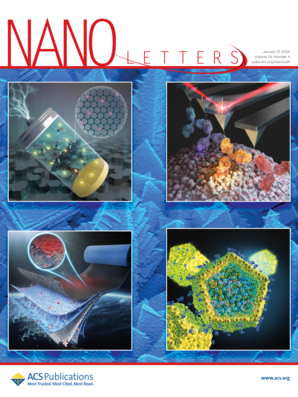A Metal–Phenolic Network Nanoresensitizer Overcoming Glioblastoma Drug Resistance through the Metabolic Adaptive Strategy and Targeting Drug-Tolerant Cells
IF 9.6
1区 材料科学
Q1 CHEMISTRY, MULTIDISCIPLINARY
引用次数: 0
Abstract
Glioblastoma (GBM) is the most lethal primary brain tumor with limited therapeutic efficiency because of resistance to Temozolomide (TMZ), which is the standard chemotherapy drug. Here, we developed the metabolic adaptive strategy based on the complex TMZ resistance mechanisms, and engineered metal-phenolic networks (TBFP-MT MPNs) by self-assembly of PEG-polyphenol encapsulating FeIII, TMZ, and dihydroorotate dehydrogenase (DHODH) inhibitor, modifying T10 and cMBP for blood-brain barrier (BBB) penetration and targeting resistant cells. TBFP-MT suppressed drug efflux by inhibiting mesenchymal epithelial transition (MET) signaling and reduced DNA repair protein O6-methylguanine-DNA-methyltransferase (MGMT) by blocking pyrimidine synthesis via DHODH inhibition. Additionally, it triggered ferroptosis by disrupting the DHODH/GPX4 defense systems, overcoming the tumor cell survival mechanisms. In vitro and in vivo studies confirmed its ability to suppress resistant GBM growth and extend survival. This study reveals drug-resistant cell vulnerabilities and provides a new pathway to overcome chemoresistance by disrupting multiple resistance mechanisms in GBM.一种金属-酚网络纳米增敏剂通过代谢适应策略和靶向耐药细胞克服胶质母细胞瘤耐药
胶质母细胞瘤(GBM)是最致命的原发性脑肿瘤,由于对标准化疗药物替莫唑胺(TMZ)具有耐药性,治疗效果有限。在这里,我们开发了基于复杂TMZ耐药机制的代谢适应策略,并通过自组装聚乙二醇多酚包封FeIII, TMZ和二氢羟酸脱氢酶(DHODH)抑制剂来设计金属-酚网络(TBFP-MT MPNs),修饰T10和cMBP以穿透血脑屏障(BBB)并靶向耐药细胞。TBFP-MT通过抑制DHODH抑制嘧啶合成,抑制间质上皮转化(MET)信号和降低DNA修复蛋白o6 -甲基鸟嘌呤-DNA甲基转移酶(MGMT),从而抑制药物外排。此外,它通过破坏DHODH/GPX4防御系统,克服肿瘤细胞的生存机制,引发铁下垂。体外和体内研究证实了其抑制耐药GBM生长和延长生存的能力。该研究揭示了耐药细胞的脆弱性,并通过破坏GBM的多种耐药机制,为克服化学耐药提供了新的途径。
本文章由计算机程序翻译,如有差异,请以英文原文为准。
求助全文
约1分钟内获得全文
求助全文
来源期刊

Nano Letters
工程技术-材料科学:综合
CiteScore
16.80
自引率
2.80%
发文量
1182
审稿时长
1.4 months
期刊介绍:
Nano Letters serves as a dynamic platform for promptly disseminating original results in fundamental, applied, and emerging research across all facets of nanoscience and nanotechnology. A pivotal criterion for inclusion within Nano Letters is the convergence of at least two different areas or disciplines, ensuring a rich interdisciplinary scope. The journal is dedicated to fostering exploration in diverse areas, including:
- Experimental and theoretical findings on physical, chemical, and biological phenomena at the nanoscale
- Synthesis, characterization, and processing of organic, inorganic, polymer, and hybrid nanomaterials through physical, chemical, and biological methodologies
- Modeling and simulation of synthetic, assembly, and interaction processes
- Realization of integrated nanostructures and nano-engineered devices exhibiting advanced performance
- Applications of nanoscale materials in living and environmental systems
Nano Letters is committed to advancing and showcasing groundbreaking research that intersects various domains, fostering innovation and collaboration in the ever-evolving field of nanoscience and nanotechnology.
 求助内容:
求助内容: 应助结果提醒方式:
应助结果提醒方式:


